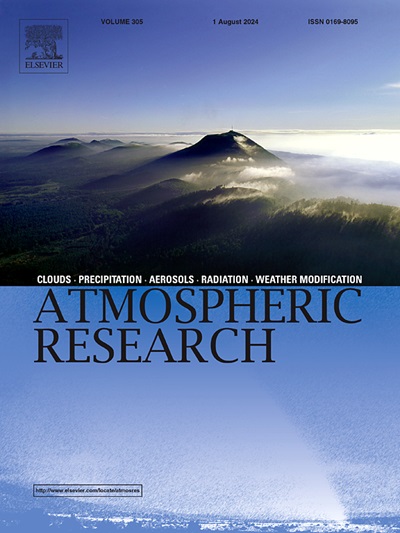Temporal variations in black carbon in the Yangtze River Delta of China: Long-term observations and trends under different pollution processes
IF 4.5
2区 地球科学
Q1 METEOROLOGY & ATMOSPHERIC SCIENCES
引用次数: 0
Abstract
As an important absorptive component of aerosols in the atmosphere, black carbon (BC) plays a key role in climatic processes. Continuous BC measurements in the atmosphere of Nanjing, China, were performed from 2015 to 2022. By combining data from PM2.5, PM10, SO2, CO, NO2, O3 and meteorological variables, the temporal variations in BC during different pollution events were determined in this study. The annual mean BC concentration increased from 2015 to 2018 (0.80 ± 0.05 μg/(m3 a)) and decreased from 2019 to 2022 (0.30 ± 0.001 μg/(m3 a)). The daily variations in BC concentrations during different processes (haze, dust, ozone, fireworks and fog) in Nanjing showed different characteristics. The BC concentration increased the most during haze events (50 %–100 %), while it changed little during fog events, so BC can be used to distinguish between these two processes. During O3 pollution events, the BC concentration increased by 6 %–44 %. During dust pollution events, BC concentration decreased owing to the high wind speed. Besides, BC wasn't a major pollutant originating from Nanjing fireworks. During haze and O3 pollution events, BC concentrations tended to increase (0.45 μg/m3–1.51 μg/m3) as the pollution levels increase. It's worth noting that BC concentrations were higher in autumn (4.85 μg/m3) than other seasons during moderate haze events because of enhanced long-range BC transport. Furthermore, during O3 pollution events, high BC concentrations exacerbated BC-boundary layer (BL) interactions and sustained high O3 concentrations. Bimodal distribution of haze (O3) pollution at all levels, but the nocturnal BC concentration peak weakened during heavy haze events.

求助全文
约1分钟内获得全文
求助全文
来源期刊

Atmospheric Research
地学-气象与大气科学
CiteScore
9.40
自引率
10.90%
发文量
460
审稿时长
47 days
期刊介绍:
The journal publishes scientific papers (research papers, review articles, letters and notes) dealing with the part of the atmosphere where meteorological events occur. Attention is given to all processes extending from the earth surface to the tropopause, but special emphasis continues to be devoted to the physics of clouds, mesoscale meteorology and air pollution, i.e. atmospheric aerosols; microphysical processes; cloud dynamics and thermodynamics; numerical simulation, climatology, climate change and weather modification.
 求助内容:
求助内容: 应助结果提醒方式:
应助结果提醒方式:


